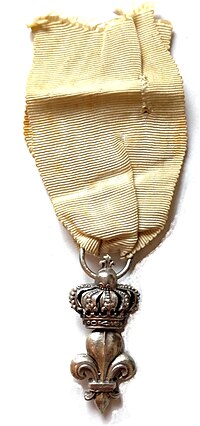Loading AI tools
French medal from 1814 to 1831 From Wikipedia, the free encyclopedia
The Decoration of the Lily (French: Décoration du Lys) was a French medal created by the Bourbon Restoration in 1814.[1]
| Decoration of the Lily | |
|---|---|
 | |
| Awarded by Louis XVIII | |
| Type | Chivalric order in one class |
| Established | April 26, 1814 |
| Status | Disestablished |
| Grades | Member |
Ribbon of the decoration | |

From the end of 1813, Napoleon's armies were fighting on their own soil, culminating in the Six Days' Campaign. Napoleon ended his reign with a series of Pyrrhic victories which could not save the Empire, and he abdicated on 5 April 1814. In a Paris occupied by the forces of the Coalition, the National Guard ensured public order by wearing a white cockade, abandoning the Revolutionary tricolour cockade, and it was on this corps that the returning Bourbons chose to found their power, rather than the Imperial armies and their officers, which they judged still to be too unreliable.
King Louis XVIII arrived in Paris on 3 May with his brother Charles de Bourbon, Comte d'Artois, the future Charles X. It was then that little medals with the image of the new king and fleurs de lys, on white ribbons, began to circulate to reassure and appease the Paris population.
One of the comte d'Artois's orders of the day, on 26 April 1814, created the Décoration du Lys for the garde nationale of Paris as "a perpetual sign of the services it has rendered, whether in fighting for their homes and, charged alone on the night of 30 March with ensuring Paris's guard and safety, preserving the king's capital for the king and the goods, lives and honour of so many families, or – when occupying posts beside those of the troops of the line – it rendered them an example of devotion and sacrifice, or when – despite this painful service – it acted as the maison militaire du Roi and granted the royal family the satisfaction of, for their guard, not being surrounded by the French."
By an order of the day on 9 May 1814, king Louis XVIII approved the creation of the Décoration du Lys, extending it to all the gardes nationales of France. It was awarded to the national guards after they took the following oath – "I swear fidelity to God, and to the King, forever" The granting of the Décoration du Lys induced the grant of an official patent.
Assuring the loyalty of the social elite to the new monarchy thanks to this simple honour, the award of the Décoration du Lys would be extended again and again, quickly starting to be awarded in all France's regions then royal officials granted them successively to generals, ministers, prefects, and finally even mayors. It was banned during the Hundred Days, then reinstated on the Second Restoration, only to be suppressed once and for all by an ordinance of Louis Philippe I on 10 February 1831.
Then it was awarded equally to officials of various administrations, to notables, to deputation members, to high-level and general officers, etc.[2]
As with the croix du Lys, some bore the inscription Gage de la paix- Vive le Roi. These bars were sometimes borne on the ribbon of the Légion d'Honneur.
The Décoration du Lys was often called the Ordre du Lys. Even if from 1824 it was controlled by the grand chancellory of the Légion d'honneur, it never had a Grand Master or a chancellory of its own, and is never called an Order in the official documents.
In 1816 the 600 National Guards serving in Paris in 1815 received the Fidelity Decoration, created by order of Louis XVIII on 5 February 1816 to replace the Décoration du Lys. Strictly speaking, it was not a new decoration but mainly a particular version of the Décoration du Lys, albeit one strictly reserved for these 600 Guards. It was in gold, and not widely awarded. Again, official texts speak of a "decoration" rather than an "order" of fidelity.
The Bordeaux Armband Decoration is a decoration created by Louis, Duke of Angoulême on June 5, 1814, and recreated on September 6, 1814, by Louis XVIII of France.[3]
As a commemoration and to his liking, this prince decorates the royal volunteers and the royal guards with the concession to wear a white bracelet with green details and a few millimeters from the edges with the embroidered arms of France.
Seamless Wikipedia browsing. On steroids.
Every time you click a link to Wikipedia, Wiktionary or Wikiquote in your browser's search results, it will show the modern Wikiwand interface.
Wikiwand extension is a five stars, simple, with minimum permission required to keep your browsing private, safe and transparent.